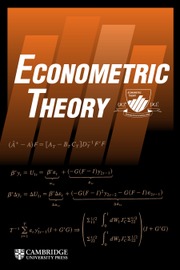Article contents
HIGHER ORDER ASYMPTOTIC THEORY FOR MINIMUM CONTRAST ESTIMATORS OF SPECTRAL PARAMETERS OF STATIONARY PROCESSES
Published online by Cambridge University Press: 24 September 2003
Abstract
Let g(λ) be the spectral density of a stationary process
and let fθ(λ), θ ∈ Θ, be a
fitted spectral model for g(λ). A minimum contrast estimator
 of θ is defined that minimizes a distance
of θ is defined that minimizes a distance
 between
between
 ,
where
,
where
 is a nonparametric spectral density estimator based on n
observations. It is known that
is a nonparametric spectral density estimator based on n
observations. It is known that
 is asymptotically Gaussian efficient if g(λ) =
fθ(λ).
Because there are infinitely many candidates for the distance function
is asymptotically Gaussian efficient if g(λ) =
fθ(λ).
Because there are infinitely many candidates for the distance function
 ,
this paper discusses higher order asymptotic theory for
,
this paper discusses higher order asymptotic theory for
 in relation to the choice of D. First, the second-order Edgeworth
expansion for
in relation to the choice of D. First, the second-order Edgeworth
expansion for
 is derived. Then it is shown that the bias-adjusted version of
is derived. Then it is shown that the bias-adjusted version of
 is not second-order asymptotically efficient in general. This is in
sharp contrast with regular parametric estimation, where it is known that
if an estimator is first-order asymptotically efficient, then it is
automatically second-order asymptotically efficient after a suitable bias
adjustment (e.g., Ghosh, 1994, Higher Order
Asymptotics, p. 57). The paper establishes therefore that for
semiparametric estimation it does not hold in general that
“first-order efficiency implies second-order efficiency.”
The paper develops verifiable conditions on D that imply
second-order efficiency.This paper was
written while the first author was visiting the University of Bristol as
a Benjamin Meaker Professor. The second author was previously at Bristol
and is now supported by a fellowship of the Royal Netherlands Academy of
Arts and Sciences. We are grateful to the co-editor Pentti Saikkonen and
two anonymous referees for their valuable comments, which significantly
improved the paper.
is not second-order asymptotically efficient in general. This is in
sharp contrast with regular parametric estimation, where it is known that
if an estimator is first-order asymptotically efficient, then it is
automatically second-order asymptotically efficient after a suitable bias
adjustment (e.g., Ghosh, 1994, Higher Order
Asymptotics, p. 57). The paper establishes therefore that for
semiparametric estimation it does not hold in general that
“first-order efficiency implies second-order efficiency.”
The paper develops verifiable conditions on D that imply
second-order efficiency.This paper was
written while the first author was visiting the University of Bristol as
a Benjamin Meaker Professor. The second author was previously at Bristol
and is now supported by a fellowship of the Royal Netherlands Academy of
Arts and Sciences. We are grateful to the co-editor Pentti Saikkonen and
two anonymous referees for their valuable comments, which significantly
improved the paper.
- Type
- Research Article
- Information
- Copyright
- © 2003 Cambridge University Press
References
REFERENCES
- 4
- Cited by


